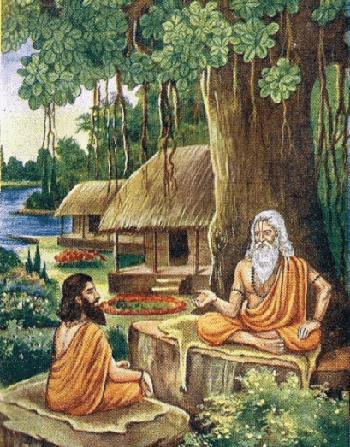The history of Gurukuls is the history of India’s education system and how it gave birth to subjects like astronomy, mathematics, science, economics, history, etc. Its history encompasses at least 15000 years which no other civilization can boast of. In the development of Indian culture, the system of 4 Purusharthas, 4 Varnas, and 4 Ashrams has been instrumental. The Gurukul system has acted as a great support system for them all.
The word “Gurukula” or “Gurukulam” is made up of two words “Guru” and “kula“. It translates literally to ‘the lineage/clan of the guru’. But it has been used for centuries in the sense of educational institutions in India.
Gurukul system of education in the Vedic period

The Gurukul system of education in India flourished during the Vedic period. Gurukuls acted as the main center of learning in ancient times. In gurukuls, Brahmacharis(students), or Satyanveshi Parivrajakas from far-off places used to come to complete their learnings. Those Gurukuls were of all kinds, small or big.
मुनीनां दशसाहस्रं योऽन्नदानादि पोषाणात। अध्यायपति विप्रर्षिरसौ कुलपति: स्मृत:।
Sages who nourished ten thousand sages or students and gave education were called the Kulpati (Vice-Chancellor)
It is clear from the use of the word ‘Smriti’ quoted above that the tradition of taking this special meaning of the Vice-Chancellor was very old. The general meaning of the patriarch was the owner of a clan. This clan could be either a small and undivided family or a large and many small families of the same origin.
The antevasi student was a member of the great academic family of the Kulpati. The responsibility for his mental and intellectual development rested with the Kulpati. The Kulpati was also concerned about the physical health and well-being of the students. Nowadays the term is used for the ‘Vice Chancellor’ of the university.
Mention in Pali literature
Many such discussions are found in the Pali literature, from which it is known that kings like Prasenjit donated many villages to those Brahmins who were involved in the field of Vedas. They used to run Gurukul for the distribution of Vedic education and helped in the study of Vedic literature. This tradition was often continued by most of the rulers and there are many inscriptions of the Gurukul running in the villages donated to the Brahmins of South India. The developed forms of such Gurukuls were Takshashila, Nalanda, Vikramshila, and Valbhi University.
It is known from the travel records of Xuanzang(Hiuen Tsang), Faxian(Fa-Hien), and many other references that in those universities, students from far-off places used to come to study. Varanasi was the main center of education since ancient times and till recently there have been hundreds of Gurukuls, Pathshalas and Annakshetras kept running for their sustenance.
Vedic period
This is the time when the Vedic Gurukul system was developed, and its structure and principles were refined. The core principles that were envisaged by rishis still hold to the very essence even in this modern age. The learning system that was set up for learning Vedas slowly evolved into the application of learning vocational as well as scientific systems.
Though there isn’t much information available except some gurukuls that have been discussed in Brahmanas (commentaries on Vedas).
Gurukuls mentioned in Ramayana & Mahabharata

Some of the famous rishis/gurus who find mentioned in the Indian epics Ramayana and Mahabharata also ran famous gurukuls. Rama and Krishna also studied in Gurukuls under Vashishtha and Sandeepani respectively.
Maharishi Vishwamitra
He wrote the Gayatri Mantra and was also the teacher of Lord Ram and Laxman. He taught them the usage of celestial weapons (Devastras) to be used in warfare. He guided them in defeating powerful demons like Tataka, Maricha, and Subahu.
Maharishi Valmiki
Sita took refuge at his ashram and gave birth to Luv and Kush, he taught them shastras and the art of using weapons. He also wrote Ramayana.
Maharishi Vashishtha
He was one of the great Saptrishis. He was a teacher to Dashrath’s sons Ram, Lakshman, Bharat, and Shatrughan.
Guru Dronacharya
He was the guru of all the Kauravas and Pandavas, who learned under guru Dronacharya. His gurukul was situated somewhere near the present-day “Gurugram” which also gets its name from.
Naimisharanya
It was one of the most important hermitages. It was more like a university. Saunka rishi was the Kulapati of this hermitage which means at least 10,000 disciples and acharyas used to reside in this hermitage at one time. This is famous by the name Chakra Teerth, Neemsar in the state of Uttar Pradesh.
Kanva Rishi Hermitage
Kanva rishi’s hermitage is described in vivid detail in Mahabharata. It was situated on the banks of the river Malini, a tributary of the Sarayu River. This hermitage was not a stand-alone but many other hermitages were there in its vicinity.
Vyasa’s hermitage
It was one of the most famous seats of learning. Vyasa compiled all the Vedas in this hermitage.
Buddhist period
Buddha was born in the 19th century BCE and Ashoka of the Mauryan empire ascended the throne somewhere around 1500 BCE as claimed by Mr. Vedveer Arya in his commendable work on the dating of Adi Sankaracharya and Buddha.
Due to the initial patronage by Maurayan Ashoka, Buddhism spread fast. It didn’t have as much effect on the gurukul system as it had on the principles of Vedic Dharma (as Hinduism was called back then). The Gurukul system continued flourishing, but much earlier Vedic Vishwavidyalayas were slowly converted into Bodh maha viharas as was the case with Takshashila and many others. Vedic dharma took the backseat while Buddhism was in the driving seat.
Education Beyond the Gurukul i.e. universities of ancient India
Some of these gurukuls evolved organically into what we call universities nowadays. The reasons may have ranged from the spread of their fame far and wide and students might have started flocking to these well-known places giving rise to universities. These served as centers/institutions for advanced learning.
According to one estimate, there were well over 50 universities in ancient India at one time. Some of these famous ones are Takshashila, Nalanda, Vikramshila, and Valbhi University, Odantapuri, Mithila University, Telhara University, Sharda Peeth Temple University, Pushpagiri University, Somapura University, Bikrampur University.
Some of the famous alumni of Takshashila(Taxila) were the noted grammarian Panini, who wrote the famous book Ashtadhyayi, and Acharya Chanakya, who wrote Arthashastra.